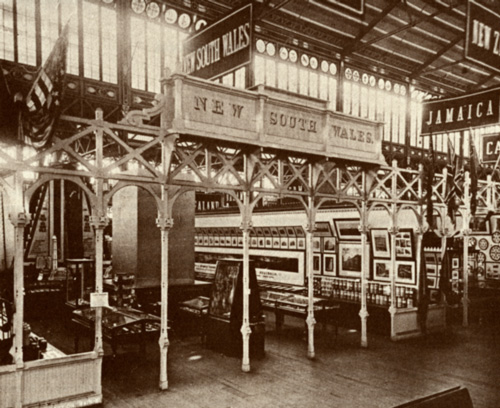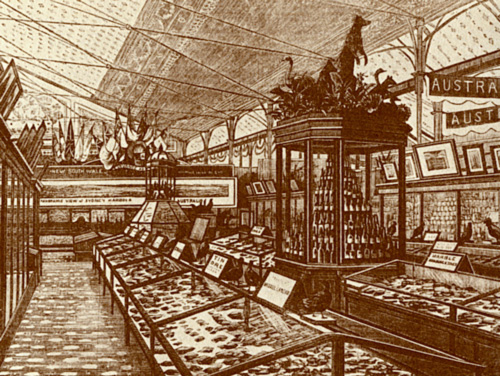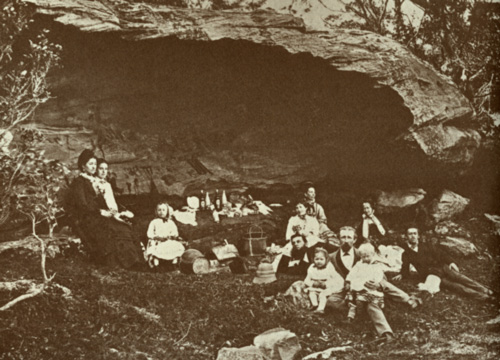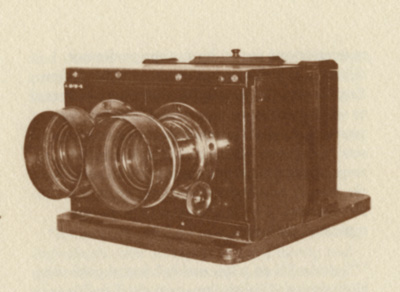Bernard Otto Holtermann (part 3)
>> see also A. P-R. 1953
It was thus made clear that it was not only Australia that Holtermann wished to impress but the great world overseas, which knew so little of the achievements and potential of his adopted country. And if any notice was ever to be taken of Australia, it would have to be at the forthcoming Philadelphia Centennial Exhibition of 1876, planned to celebrate the Declaration of Independence and the first of the modern international Exhibitions, and at the Paris Exposition Universale Internationals de 1878.
For Holtermann the year 1876 was an exceedingly busy one. First of all, as he was to be abroad for several years, he had to appoint a manager to control his various mining and land enterprises during his absence and for this position he nominated William James Slack, whom he had known as a hotel-keeper and postmaster at Hill End. Holtermann arranged to take with him a series of the photographs mounted on a great roll of canvas - measuring 5' by 80' - which could be unrolled and its contents described during his public talks. He also took with him one or more of the giant plates by way of visual proof of his tour-de-force.
A large number of Merlin's and Bayliss's pictures, including the panorama, appear to have been accepted by the New South Wales Government for display in its official stand at the Exhibition. A contemporary illustration shows that a large number were used and were well displayed around the walls. Sailing day for the City of San Francisco (3,000 tons, Captain Waddell), bound across the Pacific for the city of that name, was 2 June.
Aboard, amongst the passengers listed, were 'Mr. and Mrs Bernard Otto Holtermann, the Misses Sophia and Harriet Esther Holtermann and Miss Emmett' (a sister-in-law). San Francisco was reached in early July and Holtermann lost no time in contacting the city's photographic society.
The occasion was reported in the local press and reprinted in the Sydney Evening News for 1 September:
'The Photographic Society of the Pacific Coast held a regular monthly meeting last evening in the galleries of Messrs Bradley & Ralston, Montgomery Street, San Francisco. Mr Ralston proposed the name of Mr B. 0. Holtermann, of Australia, for membership. Mr Ralston offered the following resolution: 'That as photographers we are indebted to the liberality of B. 0. Holtermann for demonstrating the possibility and perfecting the production of the largest negative, and we tender him our thanks of this Society for kindly placing the negative on view for inspection.
'Mr B. 0. Holtermann, responding to the resolution on his behalf, begged the Society to accept his sincere thanks for the reception he had received in San Francisco by the fellow members of his profession.'
From San Francisco, the family (and the precious photographs) hastened by rail eastward across the great continent. But when the train reached the city of Burlington, on the right bank of the Mississippi River, about two hundred miles from Chicago, a stop-over was necessary, and fully explained in the columns of the Burlington Hawk Eye of 25 July 1876:
'There was a native Australian born in Burlington yesterday . . . B. 0. Holtermann, a resident of Sydney, Australia, and member of an extensive arm, Holtermann & Company, of that place, is on his way with his wife and daughters and a servant to Hamburg, Germany. Careful of the comfort of his family, he chose the shortest and safest route across the continent, which is well known to be the C. B. & Q. (chicago, Burlington and Quincy Railroad) and Holtermann, after changing his through checks for his baggage for depot checks, sought and obtained commodious and comfortable quarters at the Barrett House, where, in Room Number 39, within two hours, a son was born unto him whom he would do well to christen Burlington.'
It was typical of Holtermann that he should have accepted the Hawk Eye's suggestion, and the son was duly christened Burlington Otto Holtermann went even further-the second and third sons were also geographically named: Sydney and Leonard (St Leonards). Burlington was to die on 27 June 1897, just before his twenty-first birthday.27
As soon as Mrs Holtermann and young Burlington were able to travel, the party continued on to its destination, Philadelphia. When the awards at the centennial were announced, Holtermann's photographic exhibit received the honour of a Bronze Medal - a recognition of high order, since there were no medals in silver.

Holtermann's exhibit of New South Wales photographs on display at the Philadelphia Centennial Exhibition of 1876. By courtesy: Free Library of Philadelphia.
It is impossible for people of the present generation, familiar since childhood with the world's great inventions from many nations, to appreciate the glamour and public appeal of the great international exhibitions of last century. Nearly ten million visitors passed through the turnstiles during the I59 days the Philadelphia Centennial was open, while the maximum attendance for any one day was 274,919. Presumably a substantial percentage of these visitors would have seen the New South Wales Court with the Holtermann panorama and its scores of supporting photographs and returned home knowing rather more about the place than they had previously.
The party also made several inspections of the American and various international exhibits. Holtermann visited the American Typewriter Company display where he was presented with a neatly typed error-free copy, entirely in capitals, of John Greenleaf Whittier's 'Centennial Hymn' as sung at the Exhibition opening. This sheet was preserved among his souvenirs - an excellent example of early machine work.
Of Holtermann's European stay, it is only possible to generalise. Later, in his parliamentary days he spoke of his tour of Germany, France and Switzerland, lecturing and explaining his photographic exhibit. Hamburg was reached in the early autumn of 1876 and some time would have been spent visiting relatives and friends whom he had not seen for almost twenty years. It must have been pleasant to return to his homeland a successful man, to display his roll of photographs with a real sense of achievement, and to speak with conviction of all that eastern Australia had to offer.
He spent some time considering suitable agencies for his importing business and some of these will be mentioned later. His name appears in the Sand's Directory for 1877, the entry which would have been arranged before he left Sydney reading 'Commission Agent, 42 Pitt Street'.
The party left Germany for England in December 1877. The next date of importance relates to his success at the great Paris Exposition Universelle Internationals de 1878, where his photographs were awarded a Silver Medal.

Holtermann's panorama of Sydney on display at to Paris Exposition Universelle Internationals de 1878. Australian Town and Country Journal, 27July 1878.
Back in Australia he demonstrated his belief in press advertising by numerous displays, especially those for his principal agency, the Davis Vertical Feed Sewing Machine, a held in which he had several energetic competitors. He advertised, continuously, the merits of his Holtermann Life Drops, a herbal remedy compounded from a formula which, as a young man, he had received from a doctor in Germany, usually with an illustration of himself standing beside the 'nugget'. One copy only survives of his most striking display - and that, happily enough, is in the Royal Hotel, Hill End, where . it has long been a tourist attraction.
Holtermann is also reported to have been the first to import German lager beer on a considerable scale and this is supported by the preservation amongst his papers of a bottle label which reads : 'Brauerei zum Bayerischen Lower Lager-Beer, special (sic) prepared and imported for the Australian Colonies.' In addition Holtermann had many other agencies which he handled from his handsome new four-storey building at 674 George Street. 28

A picnic at Middle Harbour soon after the Holtermann family's return to Sydney from Europe in 1878. In the foreground Holtermann holding Esther (left) and Burlington; Mrs Holtermann is behind her husband to the left; the eldest daughter Sophia seated on the far left; the other members of the party have not been identified. (Photographed with Holtermann's Attewill stereo camera by a member of the party.)
The Sydney International Exhibition of :879 was staged in the 'Garden Palace'. It is pleasant to note that an entire bay was devoted to a Holtermann photographic collection, with acknowledgement to Beaufoy Merlin and Charles Bay1iss.29 Holtermann's interest in photography continued as a pioneer wet-plate Amateur. In 1881 he personally photographed a panorama of Sydney on I0'' by 22'' plates, perhaps because the previous series proved too large for ready sale.
He purchased a stereo camera for taking stereoscopic pairs — this an 1878 model by Attewill and Company of London, with a pair of Ross Lenses.30 In various formats, he recorded sundry travels, family picnics, birthday celebrations and scenes around the home — some at the 'tower' house, some at his new home, St Leonard's Lodge in West Street, between the present Myrtle and Burlington Streets, to the west of St Leonards Park. Its principal function completed, the 'tower' house in Union Street was leased and later sold.31 In 1880 he was living in William Street until the family moved permanently to the Lodge.

Holtermann's stereoscopic camera, an 1878 model by Attewill & Company, London. By courtesy : Museum of Applied Arts and Sciences, Sydney.
>> continues
Introduction / Processes / Holtermann / Merlin / Bayliss / Iconography / the Plates / Bibliography
>> see also A. P-R. 1953
The text and notes to the plates: copyright © Keast Burke 1973
The original GOLD AND SILVER plates were taken from the Holtermann negatives, Mitchell Library Sydney.